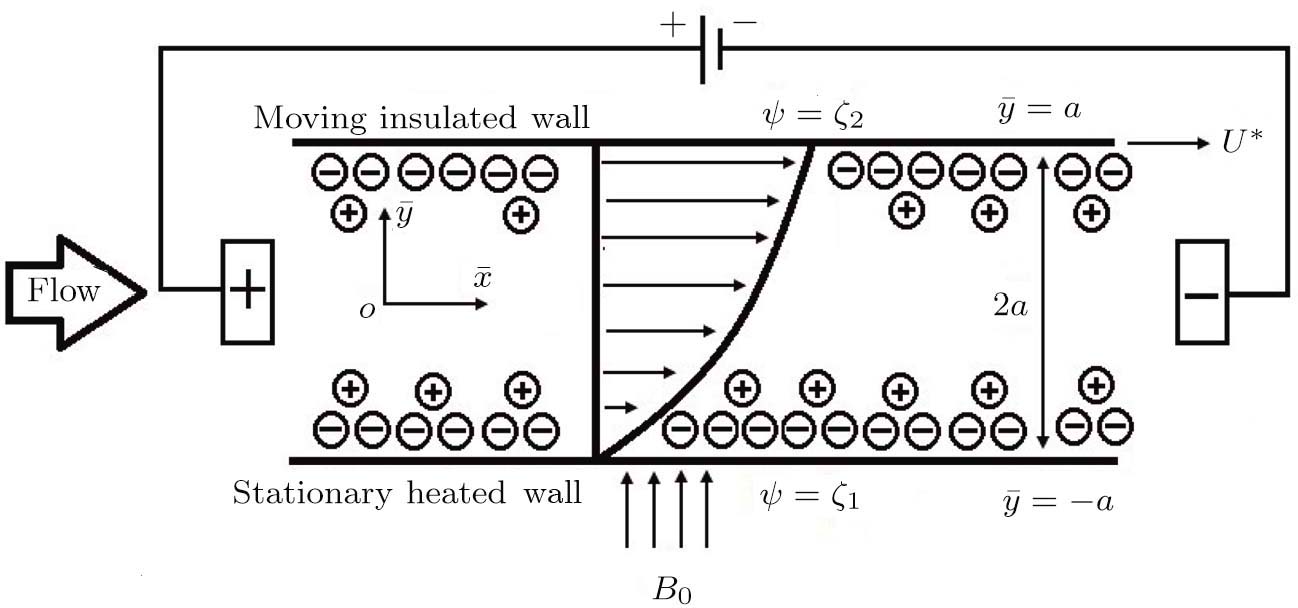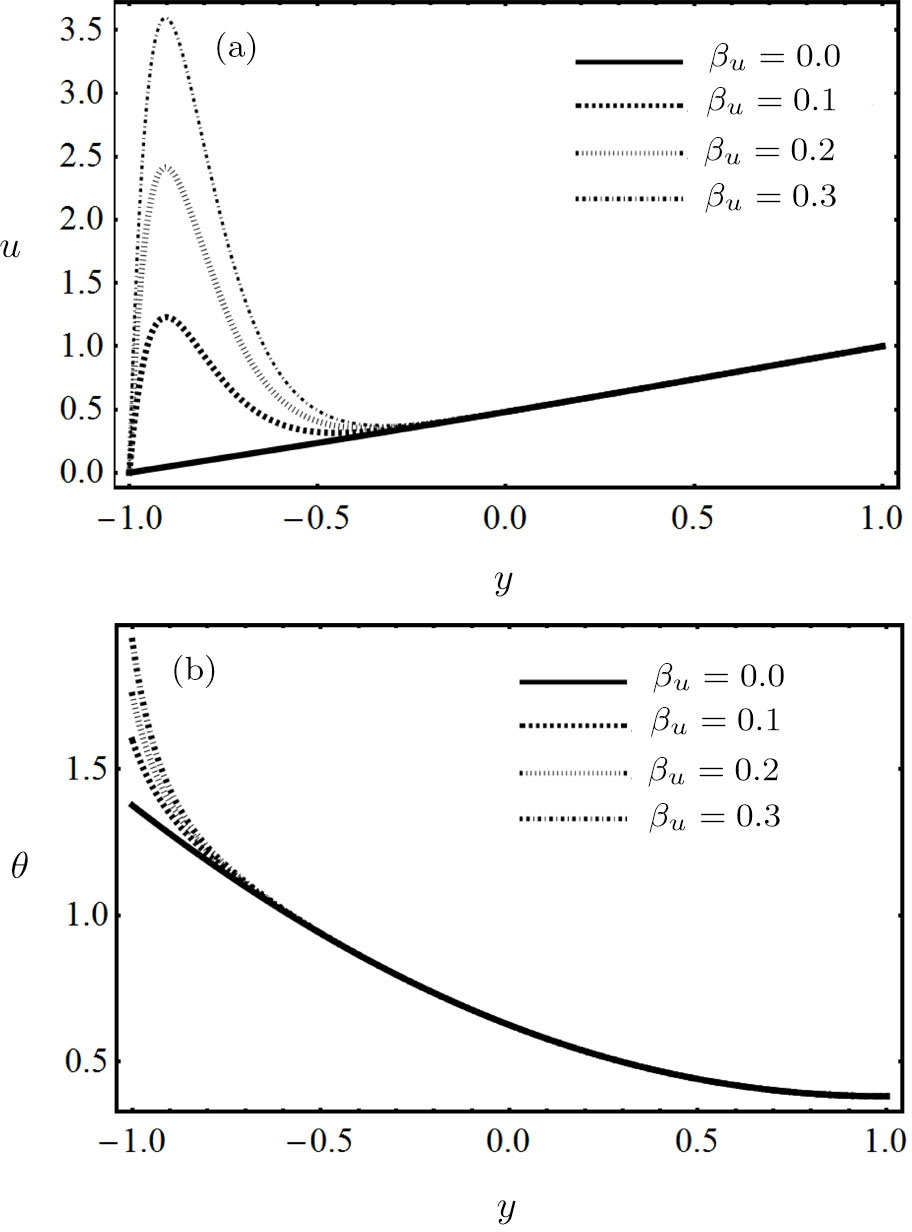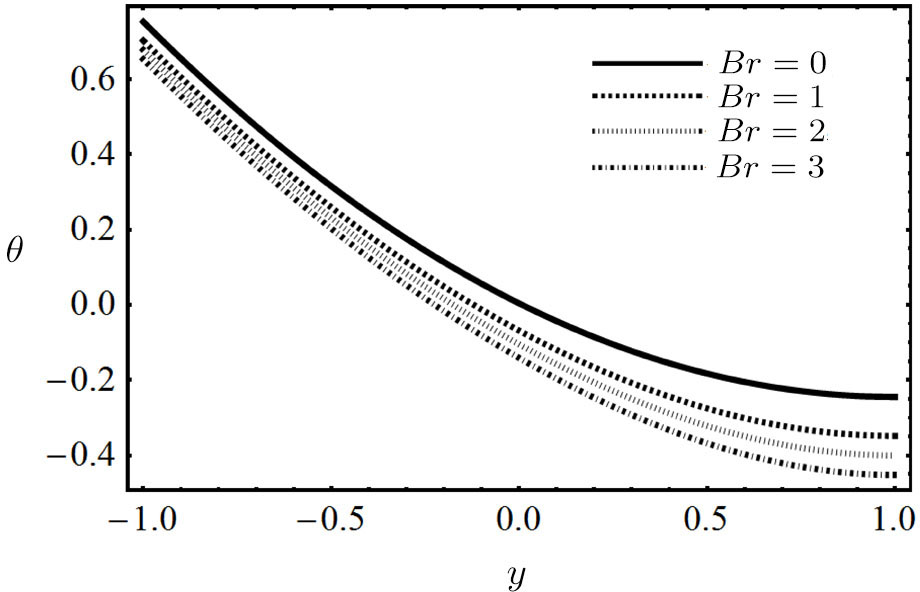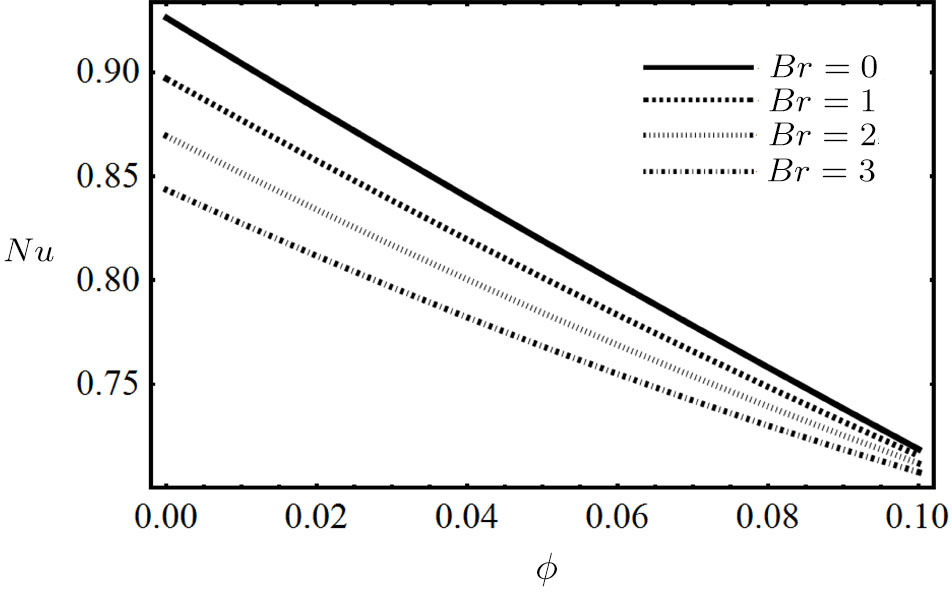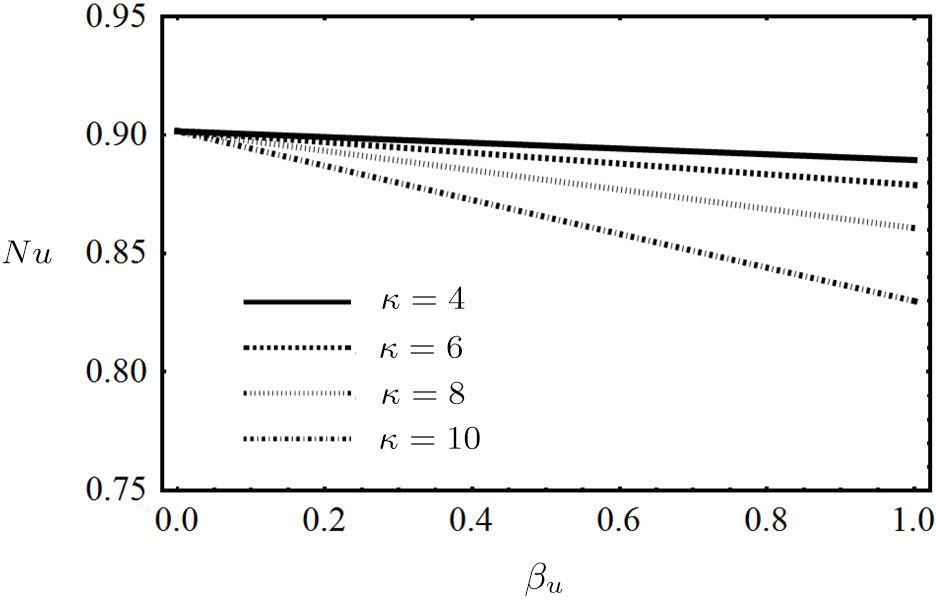† Corresponding author. E-mail:
The current manuscript is reported about the electro-osmotic Couette-Poiseuille flow of power law Al2O3-PVC nanofluid through a channel, in which upper wall is moving with constant velocity. The influences of magnetic field, mixed convection, joule heating, and viscous dissipation are also incorporated. The flow is generated because of constant pressure gradient in axial direction. The resulting flow problem is coupled nonlinear ordinary differential equations, which are at first modeled and then transform into dimensionless form through appropriate transformation. Analytical solution of the governing is carried out. The impact of modified Brinkman number, modified Magnetic field, electro-osmotic parameters on velocity and temperature are examined graphically. From the results, it is concluded that the Skin friction at moving isolated wall decreases with the increase of electro-osmotic parameter and reverse behavior for Nusselt number at heated stationary wall occur.
Power-law index Specific heat at constant pressure [J·kg−1·K−1] Dimensional fluid temperatuer [K] Thermal conductivity [W·m−1·K−1] Net body force per unit votume Lower, upper walls of channel [m] Gravitational acceleration [m·s−2] Dimensional fluid velocity field Dimensionless pressure Constant pressure gradient Uniform transverse magnemic field [T] External electric field Dimensional upper wall velocity [m·s−1] Dimensionless upper wall velocity Dimensional Dimensionless x component of velocity Embedding parameter for velocity Embedding parameter for temperature Consistency index [Pa·s] Electron charge [C] Current density [C·m−3] Boltzmann constant [mol−1·K−1] Dimensional pressure [N·m−2] Modified Reynolds number Induced magnetic fields Axial electric field Total width of channel [m] Monified Grashof number Modified Brinkman number Modified magnetic field Ion density of bulk liquid Valence of ions Skin friciton coefficient Absolute temperature Nusselt number



Dimensional electric charge density [C·m−3] Viscosity parameter [N·s·m−2] Volumetric volume expansion coefficient [k−1] Dimensional electric charge density Electric potential EDL potential Zeta potential at lower wall [V] Dimensionless temperature Nanoparticle volume fraction Viscous dissipation Density [kg·m−3] Dielectric constant Electrical conductivity [S·m−1] Applied electric potential Zeta potential at upper wall [V] Shear stress [Pa]
Fluid Nanofluid Praticle Wall
Conventional fluids like water, kerosene, ethylene glycol and acetone etc. plays a pivotal role in many scientific, industrial and engineering applications. Their applications are in the field of chemical production, microelectronics, transportation, and air-conditioning. However, these fluids have limited thermal conductivity due to their low heat transfer characteristics. Various procedures have been adopted to enhance their heat transfer ability. A way to overcome this barrier, the enhancement for heat transfer in conventional fluids via inclusion of nanoparticles in common fluids is one of key achievement of recent era. Nanofluid are heat transfer fluids, which are combinations of particles (e.g., Cu, Ag, TiO2, Al2O3) having size (1 nm–100 nm) suspended in carrier fluid (e.g., propylene glycol, Kerosene oil, water and ethylene glycol), etc. Choi et al.[1] has made pioneering contribution to nanofluids. Later on, Pak and Cho[2] investigated that by 2.78% inclusion of Al2O3 nanoparticles in water, the heat transfer rate will be enhanced 75%. Further Xuan et al.[3] experimentally observed thermal conductivity enhancement in Cu-water nanofluid. They examined that, when 5% volume fraction of nano-size copper particles are suspended in water then thermal conductivity of nanofluid enhanced and stability remains for more than hours without any interruption. Some recent contributions are made on the said topic[4–10] over diverse geometries.
In recent years, electro-osmotic flow of power law nanofluid has gained an immense response of researchers, scientist and industrialists due to its enormous engineering applications. For the prediction of fluid flow with non-Newtonian fluids such as pseudo-plastic and dilatant fluids, the power-law model is frequently used.[11] However, the power-law model does not predict the velocity distribution correctly in the region of lower shear rates. Overcome this deficiency modified power law model[12] used to get the more accurate velocity distribution in the region of lower shear rates also for zero shear rate. Electro-kinetic effects are generated, when the ionized fluid moving with respect to a stationary charged surface under an externally applied electric field is process is called Electro-osmosis. The term electro-osmotic was first time reported in an experimental investigation using the application of an electric field porous clay diaphragm by Reuss.[13] Charge developed on the surface of nano-size particles, which are suspended in base fluid, opposite charge ions to that of the particle surface are attracted, because of the developing charged diffuse layer around the particles called electrical double layer.[14] Zeeshan et al.[15] assumed the electrically conducting fluid with uniform magnetic field in non-uniform two-dimensional channel. They observed that the magnitude of pressure rise is maximum in the middle of the channel whereas for higher values of fluid parameter it increases. Further, it is also found that the velocity profile shows converse behavior along the walls of the channel against multiple values of fluid parameter. However both Newtonian and non-Newtonian electro-osmotic peristaltic transport models[16–19] in presence of electroosmosis have been reported with and without nanofluids.
Heat transfer from the material moving continuously in a channel plays a vital role and has many applications in material processing like as continuous casting, metal forming, extrusion, wire and glass fiber drawing and hot rolling etc.[20–21] In such processes, continuously transport heat with the adjacent fluid and the fluid involved may be Newtonian or non-Newtonian and the flow situations encountered can be either laminar or turbulent. An extensive research works about steady laminar and heat transport to a Poiseuille flow in channel with the static walls has been reported by Shah and London[22] for Newtonian fluids and by Irvine and Karni[11] for non-Newtonian fluids. Couette-Poiseuille laminar, steady state heat transfer flow in parallel plates along with axial movement of one plate and pressure gradient has been examined by Hudson and Bankoff,[23] Sestak and Rieger,[24] Bruin,[25] Davis,[26] and El-Ariny and Aziz[27] for Newtonian fluids. A numerical investigation of fully developed non-Newtonian Couette-Poiseuille flow has been done by Davaa et al.,[28] Hayat et al.[29] and Hashemabadi et al.[30] They established that rate of heat transfer at heated wall is increased by increasing the Brinkman number when the flow direction is same as the movement of upper plate, but the reverse behavior can be seen when the flow direction and upper late are opposite. Marin[31] established a concept for micropolar porous media dependent on heat-flux including void age time derivative among the independent constitutive variables. Author indicated that this heat-flux theory becomes a predictive theory of light scattering, sound dispersion, shock wave structure and so on. It now appears concomitant to the kinetic theory of gases and closely related to the mathematical theory of hyperbolic systems. Forced convection MHD fluid flow around two solid circular cylinders in side by side arrangement and wrapped with porous ring has been investigated by Rashidi.[32] Author concluded that the effect of magnetic field is negligible in the gap between two cylinders because the magnetic field for two cylinders counteracts each other in these regions. Tripathi[33] discussed the influence of viscoelastic behavior, fractional nature of fluid model and transverse magnetic field on peristaltic flow pattern. He established the result that the magnitude of frictional force reduces in very small interval of volumetric flow rate then it increases with increasing magnetic field parameter.
Literature survey revealed that there is no such investigation has been reported on MHD power law nanofluid passed through the two parallel walls one of them is moving. Therefore, our current innovative study represents interesting phenomenon of Couette-Poiseuille flow of power law nanofluid under the influence of MHD. The influences of Ohmic dissipation, viscous dissipation, and electro-osmotic are also accounted. The resulting systems of coupled nonlinear ODEs are tackled through analytical method.[34–36] The following sections consist of problem formulation, solution procedure, convergence analysis, results and discussion, conclusion and references. Also the fallouts of velocity, temperature together with skin friction and Nusselt number are briefly nattered for emerging parameters modied Brinkman number and modied magnetic field at 20-th order iterations.
Consider a steady, laminar, viscous, incompressible, hydromagnetic fully developed boundary layer flow of an electrically conductive power-law non-Newtonian nanofluid passed through a channel containing two parallel straight walls at 
In non-Newtonian fluids modeling, the viscous stress is directly but not linearly proportional to the shear rate 

The shear stress (τ) of a power-law model is defined as:

As nature and behavior of nanofluid model define above, the fluid motion is generated because of axial movement of the upper plate, constant pressure gradient and electric body force produced because of EDL at the channel walls. Electro-osmotic flow (EOF) is producing by presentation of electric field around the channel walls. The governing equations of total conservation of mass, momentum and thermal energy are:



In describe model,







We assume that both walls of channel have different zeta potentials and made by different materials. The external electric field



















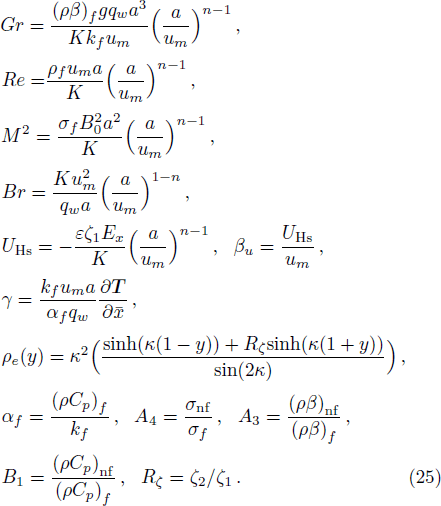

For non-Newtonian power-law fluid, shear stress can be calculated as:

| Table 2 The properties of PVC solutions[37] and power-law equation. . |
The coefficient of skin-friction along the walls is

At upper wall:







For analytical solution of Eqs. (













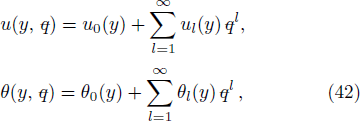

Estimate the results for ul(y) and θl(y) at l-th order deformation, as follow:






Coefficients F1, F2, F3, F4, F5, F6, F7, E1, E2, E3 are given in equations of Appendix
The analytic expressions given by Eq. (
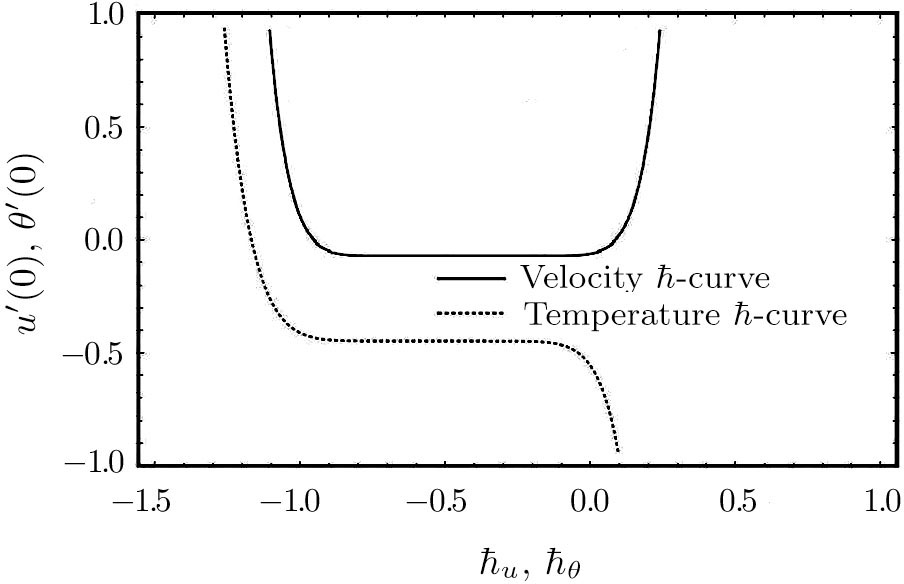 | Fig. 2 ħ-curves for velocity and temperature. Gr = 2.366, Re = 442.956, n = 0.764(PVC3%), βu = 0.3, γ = 05, Br = 01, M = 0.5, κ = 10, and ϕ = 3%. |
The residual error at two successive approximations over [0, 1] with homotopy analysis method by 20-th order approximations are obtained by using
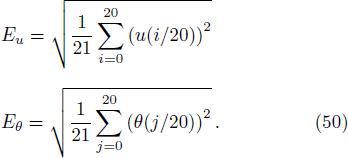
| Table 3 Convergence of series solution when Gr = 2.366, βu = 0.3, γ = 05, Br = 01, Re = 442.956, n = 0.764(PVC3%), M = 0.5, κ = 10, and ϕ = 3%. . |
In present discussion, we study the Couette-Poiseuille non-Newtonian power-law nanofluid flow in between two parallel plates. The nanofluid is driven by the constant pressure gradient also with the axial movement of the upper plate and electric body force. Flow and heat transport of power-law nanofluid model among two parallel plates is examined analytically. Lower one is externally heated and upper one is adiabatic. The influence of electro-osmotic parameter, ratio of Helmholtz-Smoluchowski electro-osmotic velocity to maximum velocity, volume concentration of nanoparticles on flow field, modified magnetic parameter, modified Brinkman number and characteristic of heat transfer are elaborated through graphically in Figs.
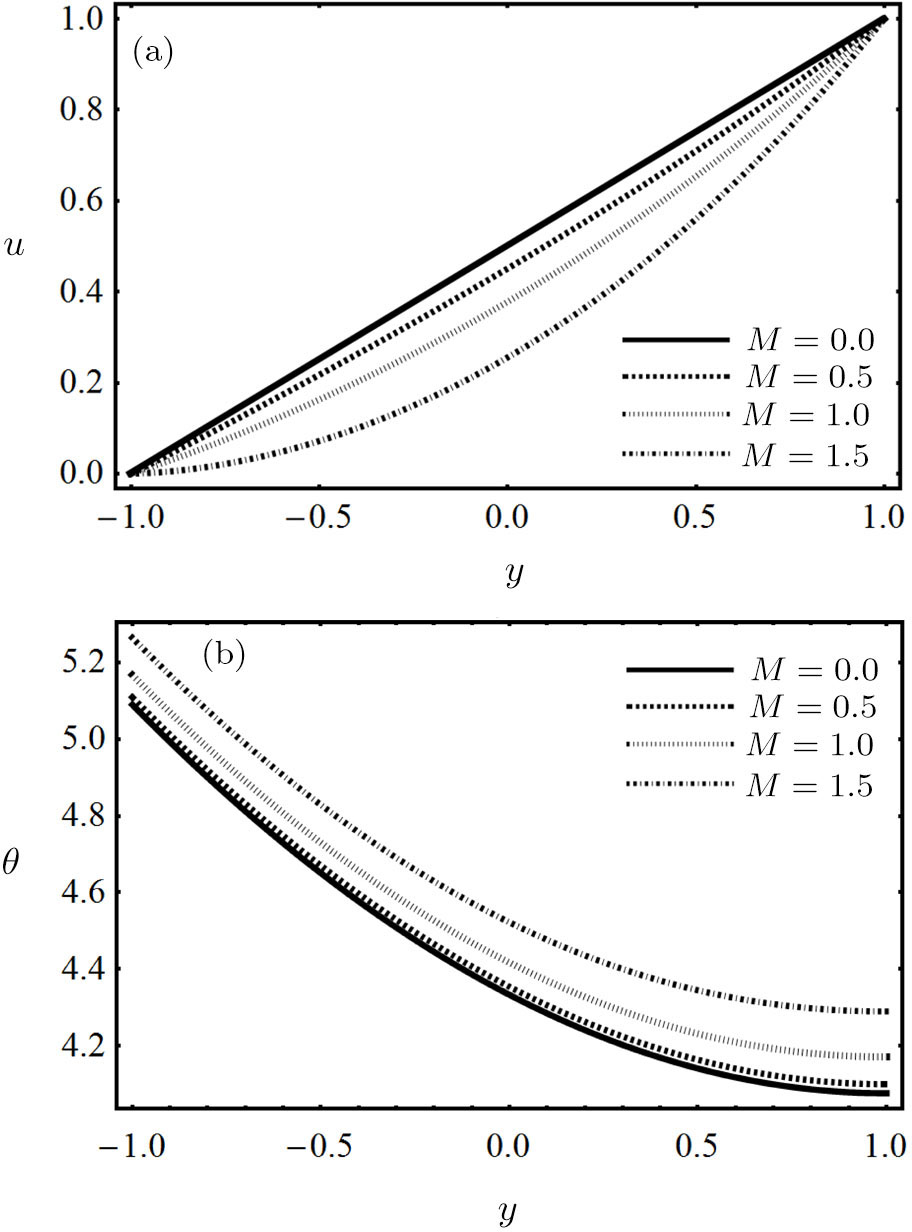 | Fig. 3 (a) Impact of magnetic parameter on fluid velocity. (b) Impact of magnetic parameter on fluid temperature. |
The effects of modified magnetic parameter M on velocity and temperature distribution of nanofluid are displayed in Fig.
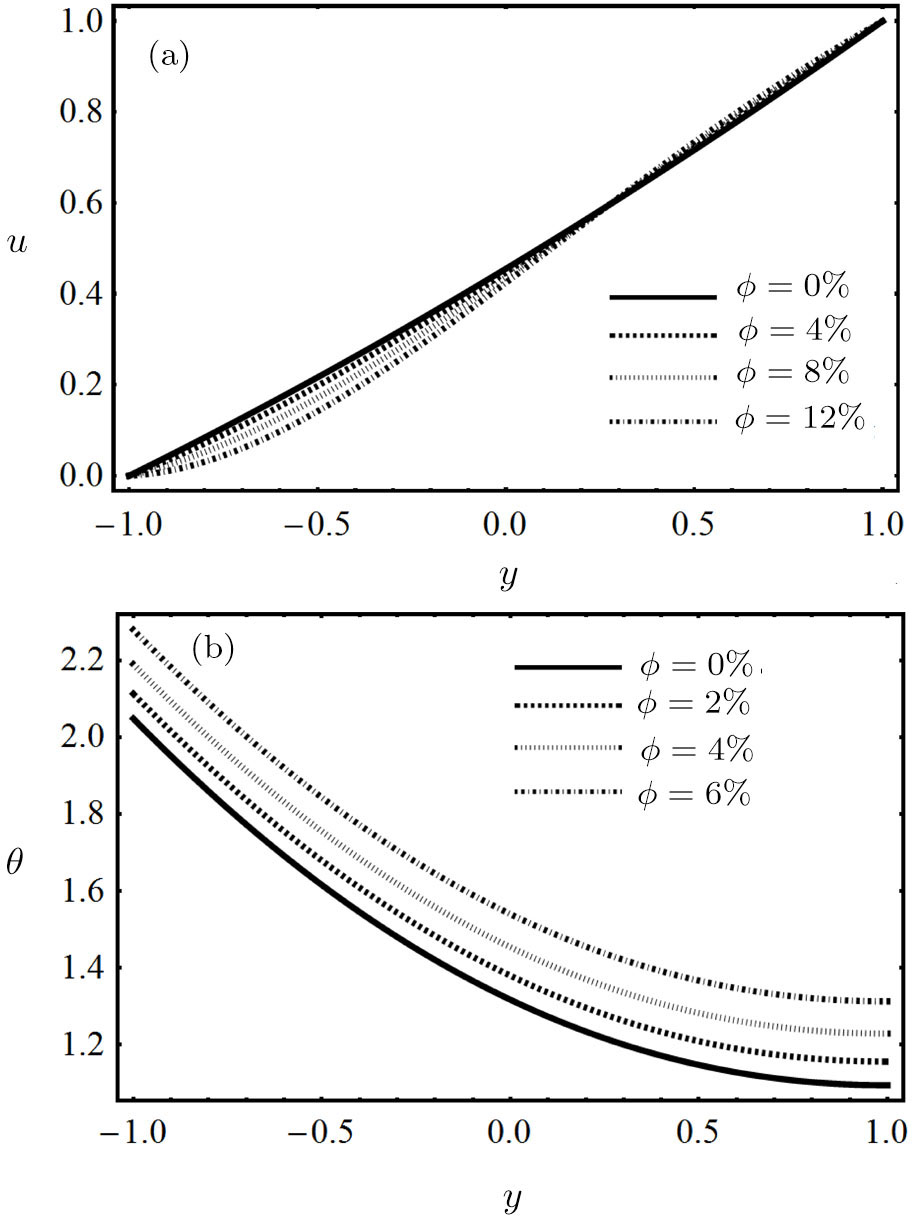 | Fig. 4 (a) Impact of nanoparticle volume fraction on fluid velocity. (b) Impact of nanoparticle volume fraction on fluid temperature. |
Different concentrations of PVC on the flow field and temperature field of nanofluid are elaborates in Fig.
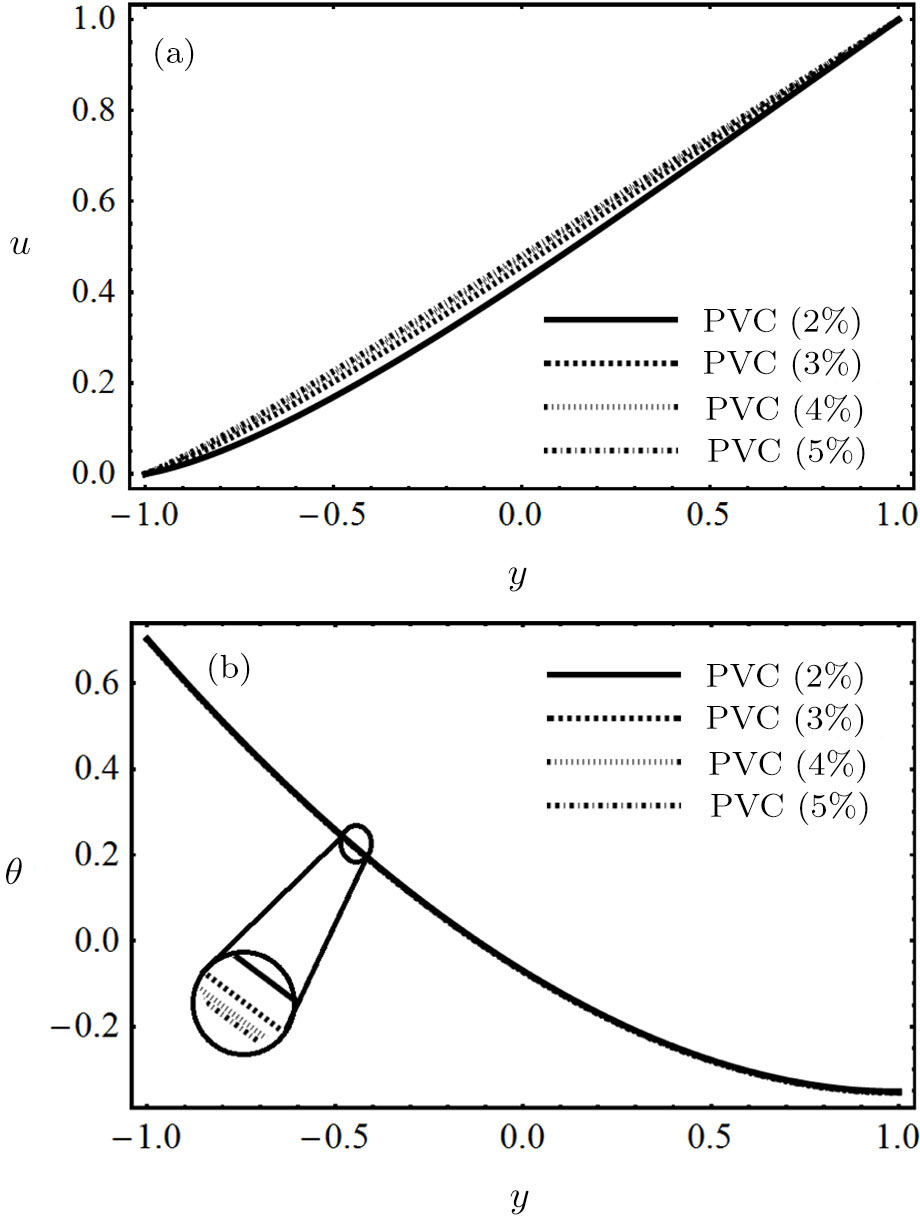 | Fig. 5 (a) Impact of PVC concentration on fluid velocity. (b) Impact of PVC concentration on fluid temperature. |
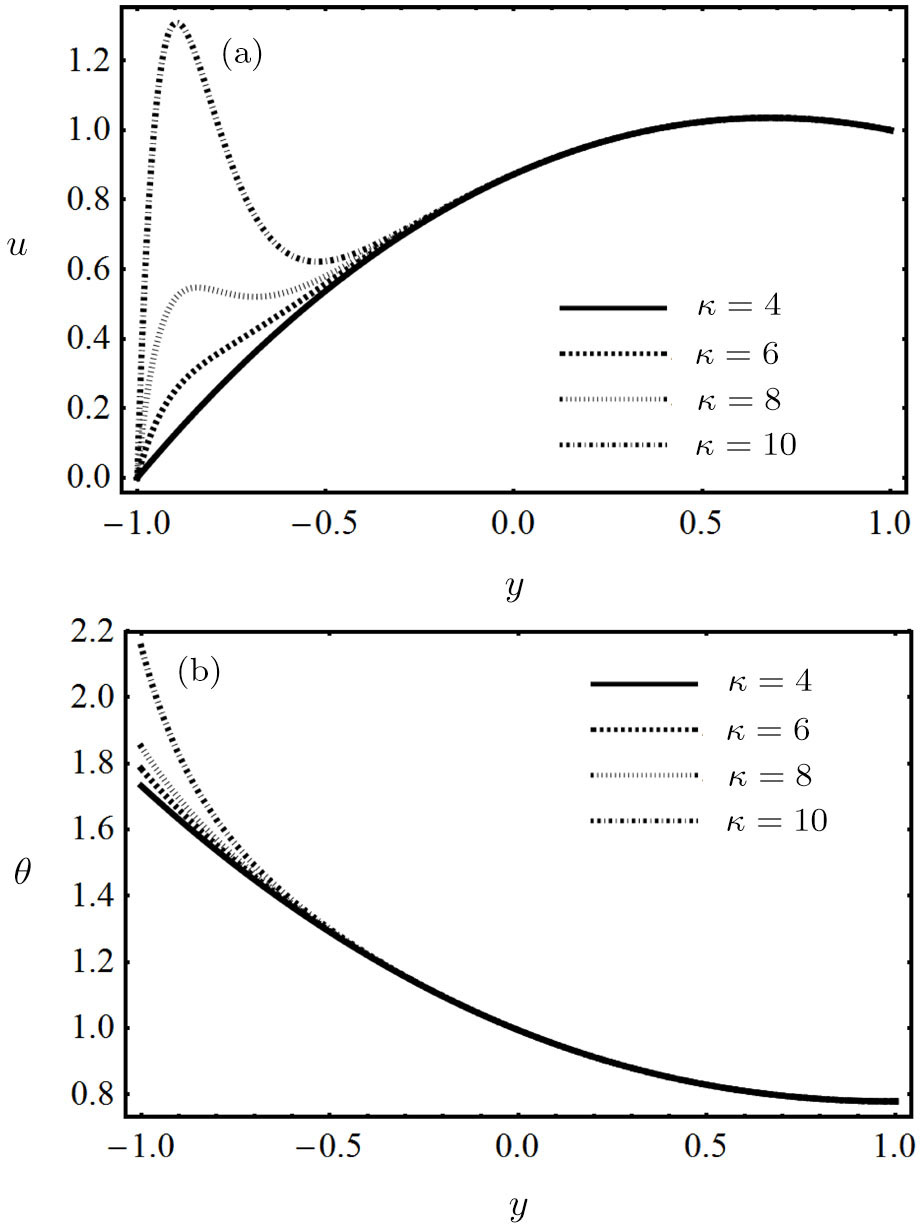 | Fig. 7 (a) Impact of electro-osmotic parameter on fluid velocity. (b) Impact of electro-osmotic parameter on fluid temperature. |
The influence of modified Brinkman number Br and γ constant on the temperature is shown in Fig.
Increasing effects on Nusselt number due to increase of nanoparticles volume fraction and modified Brinkman number are shown in Fig.
| Table 4 Skin friction coefficient Cf for several of Br, ϕ, M, βu and κ with n = 0.764(PVC3%) at both walls. . |
The present communication addresses the Couette-Poiseuille power law Al2O3-PVC nanofluid flow between two parallel plates, in which upper plate is moving with constant velocity. The influences of magnetic field, mixed convection and electrical double layer (EDL) are incorporated in momentum transfer. The energy distribution along with the joule heating and viscous dissipation are also considered. The velocity of the nanofluid is generated due to constant pressure gradient in axial direction. The flow problem is first modeled and then transformed into dimensionless form via appropriate similarity transformation. Homotopy analysis method (HAM) is utilized to tackle the resulting dimensionless flow problem. The impact of sundry parameters on fluid velocity, temperature distribution, skin friction coefficient and Nusselt number are expressed for shear-thinning nanofluid through figures. The key outcomes of the problem can be comprehended as follows:
It is perceived that the velocity of nanofluid decelerate by increasing the values of modified magnetic parameter and nanoparticles volume fraction, whereas the temperature profile is increased by increasing the said parameters. The velocity of non-Newtonian power-law nanofluid enhanced as concentration of PVC rise up, while opposite trend shows for temperature distribution. The flow and temperature are the same enlarged behavior for increasing the ratio of Helmholtz-Smoluchowski electro-osmotic velocity to maximum velocity and electro-osmotic parameter. Skin friction at externally heated wall increases with the increase of nanoparticles volume fraction and modified Brinkman number, while decreases with the increase of modified magnetic parameter, electro-osmotic parameter and ratio of Helmholtz-Smoluchowski electro-osmotic velocity to maximum velocity. Skin friction at moving isolated wall decreases with the increase of modified magnetic parameter, nanoparticles volume fraction and modified Brinkman number, while increases with the increase of electro-osmotic parameter and ratio of Helmholtz-Smoluchowski electro-osmotic velocity to maximum velocity. Nusselt number at heated wall decreases with the increase of electro-osmotic parameter, ratio of Helmholtz-Smoluchowski electro-osmotic velocity to maximum velocity, nanoparticles volume fraction and modified Brinkman number, while increases with the increase of modified magnetic parameter.
| [1] | |
| [2] | |
| [3] | |
| [4] | |
| [5] | |
| [6] | |
| [7] | |
| [8] | |
| [9] | |
| [10] | |
| [11] | |
| [12] | |
| [13] | |
| [14] | |
| [15] | |
| [16] | |
| [17] | |
| [18] | |
| [19] | |
| [20] | |
| [21] | |
| [22] | |
| [23] | |
| [24] | |
| [25] | |
| [26] | |
| [27] | |
| [28] | |
| [29] | |
| [30] | |
| [31] | |
| [32] | |
| [33] | |
| [34] | |
| [35] | |
| [36] | |
| [37] | |
| [38] | |
| [39] | |
| [40] | |
| [41] | |
| [42] |


